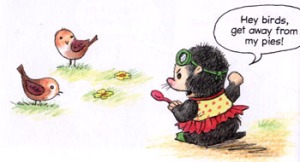Interview with Geoffrey Hayes, Award Winning Author and Illustrator
 Benny and Penny in The Big No-No!
Benny and Penny in The Big No-No!
written and illustrated by Geoffrey Hayes
Toon Book / RAW Junior, 2009
2010 Theodor Seuss Geisel Award Winner
Early Reader
If you haven’t seen Toon Books — go now and collect them all. They are hardback comic book called Toon Books and they’re for early readers. They’re darn cute, beautifully illustrated and exceptionally well plotted.
This year Geoffrey Hayes’ book, The Big No-No!, won the prestigious Theodor Seuss Geisel Award given annually by the Association for Library Services to Children to the author of the most distinguished American book for beginning readers published in the United States.
Yes, it is that good.
Let me just say that I have read so many terrible early readers that it’s made me consider trying to write my own. (I haven’t and will leave that to the professional fiction writers but I’m just sick of poor quality early readers.)
But, (insert angels singing here) . . . here came this amazing, beautiful, engaging book – The Big No-No! with a lovely message of friendship. Not only that, the characters really seem like actual kids that I’ve known.
Penny assumes that because her pail is missing, the new neighbor must have taken it and she is MAD. She goes next door to fetch her pail, throws a few mud pies at the monster neighbor and returns home only to find her pail in her own sandbox. (Sound like anyone you know?)
Penny apologizes to her neighbor and they both get a laugh when Benny slips and falls in the mud. Nothing more funny that a brother getting dirty and embarrassed!
Book Play: Play with mud. Make a mud pool for your toys, mud pies for your friends or a mud kingdom for yourself. All you need is a hose and dirt and you’re ready. Just make sure you can hose off before going back inside!
Author Interview:
Colorado Parent: I love your newest Toon book, Benny and Penny. Tell me about why you made these books specifically for early readers.
GH: I had already created the characters, and because of their ages, knew that the stories had to be either picture books or early readers. I was toying with the idea of doing a comic book reader (although not necessarily with Benny and Penny) when Francoise Mouly got in touch with me and said that she was developing a series of comic readers and wanted me to be a part of it.
CP: Why did you choose to do Toon books / cartoons for Benny and Penny?
GH: Comics have always been my first love. I’m really drawn to sequential art. In fact, when working out ideas for regular children’s books I usually start with thumbnail sketches with word bubbles. It helps me get a better sense of the personalities and actions. I wrote the first Benny and Penny story as a portfolio piece and decided to do it as a comic for my own amusement. At the time, their names were Tyler and Bella. I showed this to Franscoise, and together we decided that it would make a good Toon book.
CP: When children read Benny and Penny, or any cartoon book, how is the reading experience different or the same?
When children read a cartoon book, they initially read the words with the pictures working in the background to subliminally enhance and fill out the story. Then the reader is compelled to re-read to gather information from the pictures they may have missed on the first go round. When doing so, they also re-read the words. Since the art and text are so intrinsically connected, children read on two levels, visual and textual.
CP: Where did the idea for Benny and Penny come from?
I was doing some quick sketches one day and drew a picture of a little mouse pushing his baby sister into a laundry hamper to get rid of her. It made me laugh. I thought it was a great germ of an idea. In the final story, the action was moved outside and the laundry hamper became a small tool shed.
CP: What is your best advice for parents to get their kids reading?
Not to be too strict about it, or reading can turn into a chore. The parent should allow the child to read what they are drawn to, within reason, of course. Obviously they should censor anything they find morally objectionable, but having rules about what constitutes “good” reading vs. “bad” can hinder the child’s development. If a child is drawn to baseball cards, encourage them; gaming magazines, encourage them. Once they gain a facility for reading, they will graduate to material with more substance.
CP: Anything else you’d like to share?
Because we live in a visual age (movies, computer icons, Internet) all children seem to take instantly to comics or Graphic Novels. Children with learning disabilities are more apt to read below their age level because the comics medium prevents the stories from seeming too “babyish.” Therefore, comics can be a wonderful tool for improving children’s literacy.
CP: Thank you so much Geoffrey Hayes for sharing with us. Congratulations on your recent award, we wish you continued success in all your future books. (And thank you from all the early reader readers for writing such a delightful early reader book!)

Trackbacks